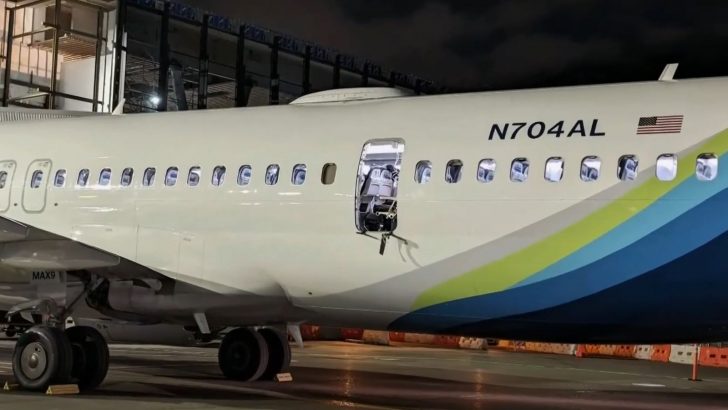While on a seemingly routine flight, Alaska Airlines Flight 1282, operating a Boeing 737 Max 9, experienced a harrowing incident that left both passengers and aviation experts shaken. Fortunately, no serious injuries were reported, and the plane landed safely. But the situation raises pressing questions about aircraft safety and Boeing's future in the aviation industry.
Minutes after departing from Portland International Airport, passengers aboard the Boeing 737 Max 9 were jolted by a terrifying event. An emergency exit door unexpectedly detached from the aircraft, creating a gaping hole in the fuselage. This incident led to a rapid decompression as air gushed out, balancing the internal pressure with the thinner external atmosphere.

Elle / Passengers aboard the Boeing 737 Max 9 were jolted as an emergency exit door detached from the aircraft.
However, this situation was less severe than it could have been since the plane was at a relatively low altitude of approximately 16,300ft. This means the plane was not at its typical cruising height of around 38,000ft.
It Could Have Been Worse!
The gravity of the situation becomes clearer when considering what might have occurred had the plane been at its cruising altitude. At 38,000ft, the disparity between internal and external pressure is significantly higher.
However, it is essential to note here that this scenario is not purely hypothetical. Tragically, it played out in 2018 with a Southwest Airlines flight operating an older Boeing 737 model, leading to a fatality.
Safety Concerns and Precautions

NBC / A similar incident at this altitude could have resulted in a much more violent decompression, posing a grave risk to passengers, especially if they were not belted in.
In the wake of the incident, Alaska Airlines made the swift decision to ground its fleet of 737 Max 9s. This precautionary measure was mirrored by the Federal Aviation Administration (FAA), which temporarily grounded 171 aircraft for thorough inspections.
The primary concern revolves around the integrity of the emergency exit doors. These doors are supposed to be securely fastened with four bolts. Given that the aircraft involved was only two months old, wear and tear is an unlikely culprit, giving credence to the mystery and concern over Boeing's manufacturing and quality control processes.
Boeing Struggles With Addressing Safety and Restoring Trust
This incident places Boeing in a precarious position. Already grappling with the aftermath of previous 737 Max issues, the company now faces renewed scrutiny over its safety standards and manufacturing practices. The challenge for Boeing is twofold.
Firstly, to identify and rectify the cause of this incident promptly. Secondly, to restore public trust in its aircraft, which is crucial for its survival in the competitive aviation market.

Getty / Boeing struggles with identifying the unexpected detachment of exit doors and regaining public trust.
The Broader Implications of the Incident
This mid-flight blowout is not just a problem for Boeing. It is a wake-up call for the entire aviation industry. It underscores the need for stringent safety measures, regular maintenance checks, and robust regulatory oversight. The FAA's response will be closely watched as it sets a precedent for how aviation authorities worldwide handle similar crises.
As Boeing navigates through this latest challenge, the aviation world and its passengers watch with bated breath. While the outcome of this incident was a fortunate one, it highlights an urgent need for reassessment and reinforcement of aviation safety standards, not just for Boeing but for the entire industry.









